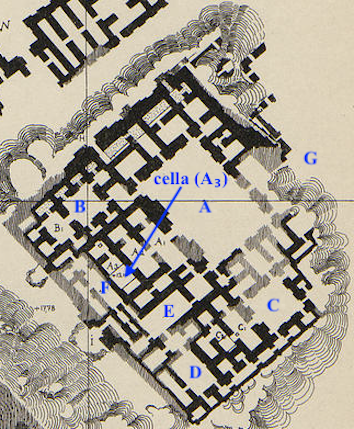Ešidduannaki (cella of Nabû in Ezida at Borsippa)

Ešidduannaki is referred to as the "the cella of his (Nabû's) lordly majesty" (Akkadian papāhi bēlūtīšu) in an Akkadian inscription of the Neo-Babylonian king Nebuchadnezzar II (r. 604–562 BC) on bricks discovered in the brickwork underneath Nabû's dais in Ezida; that text records the construction of the brick platform (Akkadian diʾu) upon which the image/statue of Borsippa's tutelary deity stood. In Nebuchadnezzar's inscriptions, Nabû's cella is usually called Emahtila and, thus, Ešidduannaki is either a byname of Emahtila or a specific part of it.
Names and Spellings
The Sumerian ceremonial name Ešidduannaki means "House of the Director of Heaven and Netherworld." The name is known only from a single royal inscription of Nebuchadnezzar II.

Annotated extract from R. Koldewey, Die Tempel von Babylon und Borsippa, pl. XI. Nabû's cella and throne platform are labelled A₃.
- Written Forms: e₂-šid-du₃-an-na-ki.
Known Builders
- Neo-Babylonian (ca. 625–539 BC)
- Nebuchadnezzar II (r. 604–562 BC)
Building History
During his renovations on Ezida, Nabopolassar's son and immediate successor Nebuchadnezzar II rebuilt Nabû's dais, which was said to be located in Ešidduannaki. That ruler states in an inscription written on bricks that he firmly set that throne platform in place using baked bricks (Akkadian agurru) and bitumen Akkadian kupru).
Archaeological Remains
From the find spots of the bricks bearing the Akkadian inscription of Nebuchadnezzar II, in the brickwork under the throne platform in Room A₃, the main cella of Nabû in Ezida is probably to be identified with Ešidduannaki. That room was excavated by Robert Koldewey on behalf of the Deutsche Orient-Gesellschaft (DOG) and Königliche Museen Berlin (KMB) during the German excavations at Borsippa in 1901–02. Parts of the lower portions of the unbaked brick walls, baked brick floor, and dais were preserved. The brick substructure underneath the throne platform stretched down at least 13 m, to the level of the groundwater (in April 1902); several inscribed bricks of Nebuchadnezzar II were discovered in situ in that excavation trench dug by Koldewey's workmen in 1902.
Further Reading
- George, A.R. 1993. House Most High. The Temples of Ancient Mesopotamia (Mesopotamian Civilizations 5), Winona Lake, p. 146 no. 1049.
- Koldewey, R. 1911. Die Tempel von Babylon und Borsippa (Wissenschaftliche Veröffentlichungen der Deutschen Orient-Gesellschaft 15), Leipzig, pp. 50–59.
- Unger, E. 1932. "Barsippa," Reallexikon der Assyriologie und vorderasiatische Archäologie 1/6, pp. 416–417 §§54–55a.
Banner image: photograph of the remains of Ezida and Eurmeiminanki taken ca. 2002 (left); woodcut from "Pleasant Hours: A Monthly Journal of Home Reading and Sunday Teaching; Volume III" published by the Church of England's National Society's Depository, London, in 1863 (center); areal photograph of the ruins of Ezida and Eurmeiminanki taken in 1928 (right). Images from Getty Images.
Jamie Novotny
Jamie Novotny, 'Ešidduannaki (cella of Nabû in Ezida at Borsippa)', Babylonian Temples and Monumental Architecture online (BTMAo), The BTMAo Project, a sub-project of MOCCI, [http://oracc.org/btmao/Borsippa/TemplesandZiggurat/Ezida/RoomsandGates/Emahtila/Eshidduannaki/]